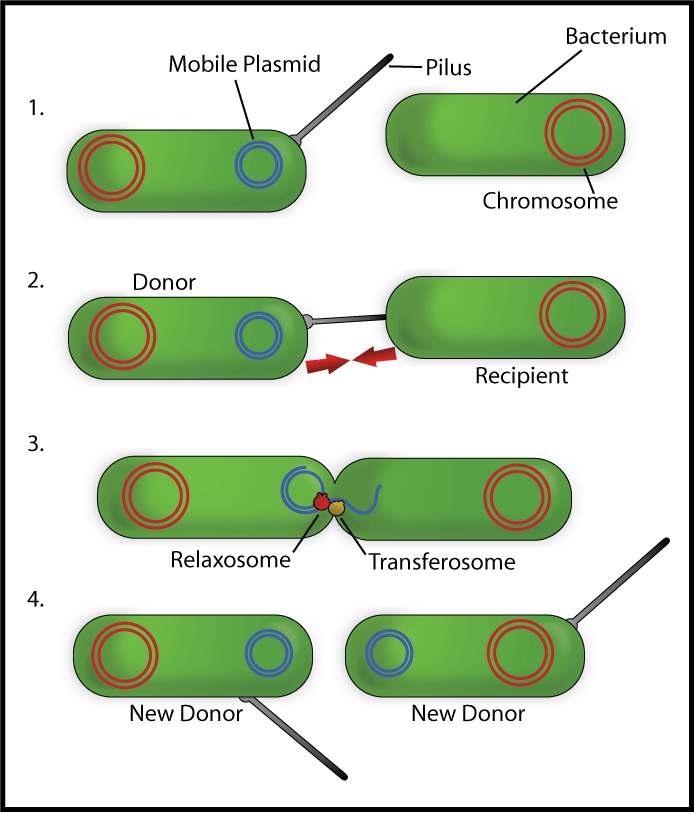Conjugation

Bacterial conjugation is the transfer of genetic material between two bacterial cell via direct cell-to-cell contact. Although often incorrectly characterized as the bacterial equivalent of mating, in fact it is simply the transfer of genetic material from a donor cell to a recipient cell. Bacterial conjugation is also known as a "type IV secretion system".
This behaviour is characterized by the presence of a specialized plasmid (small, circular piece of transferrable DNA most often found within bacteria) known as a conjugative plasmid. The conjugative plasmid holds a distinct and specialized set of coding regions including the following
- OriT (Origin of Transfer): Unlike other plasmids, the conjugative plasmid has its own origin of transfer nic region. This is a specialized portion of the genome where one of the two strands of the circular plasmid DNA is cut to allow for rolling circle replication of the plasmid containing the OriT region into a recipient cell. During rolling circle replication, the cut end of one strand is inserted into the recipient cell while recipient polymerases construct the complementary strand back into a circular piece of DNA.
- TraJ (Transfer genes): The activation of this gene sets off a cascade of other plasmid genes (and thus corresponding protein expressions) which act in concert to form "mating" characteristics in the host bacterial cell. Such salient characteristics include:
- growth of a pilus--a long whip-like apparatus used to hook the two cells together
- fusion of the outer membranes to allow for transfer of genetic material
- formation of "surface exclusion proteins" which prevents the cell containing the conjugative plasmid from mating with other conjugative plasmids of its type
Two of the most well-studied and characterized types of conjugative plasmids are types "F" (from the F plasmid) and "R". The employed nomenclature for conjugative plasmid genes is the gene name first with the type afterwards. For example, the "TraJr" or "TraJR" gene denotes the "TraJ" gene of the "R" type conjugative plasmid.
Note it was previously believed that transfer of genetic material occurred via the pilus itself; now, most think that the transfer of genetic material occurs via a separate direct channel between the two cells.
| Name | Type | Description | Length | Status |
|---|---|---|---|---|
| BBa_I714030 | Conjugation | OriT-F (Origin of Transfer for the F-plasmid nic region) | 355 | In stock |
| BBa_I714031 | Conjugation | OriT-R (Origin of Transfer for the R751-plasmid nic region) | 278 | In stock |
| BBa_I714032 | Conjugation | OriT-S (Origin of Transfer for the pSC101-plasmid nic region) | 131 | It's complicated |
| BBa_J01002 | Conjugation | OriT-F (Origin of Transfer for the F-plasmid nic region) | 365 | It's complicated |
| BBa_J01003 | Conjugation | OriT-R (Origin of transfer for the R-plasmid nic region) | 371 | In stock |
| BBa_K125320 | Conjugation | OriT-RP4 (Origin of transfer for the RP4 plasmid) | 99 | It's complicated |
| BBa_K125350 | Conjugation | oriTr with lac promoter and lacZ | 979 | It's complicated |
| BBa_K125360 | Conjugation | oriT with lac promoter and lacZ | 707 | It's complicated |
| BBa_K175000 | Coding | trbC (pilin) of IncP beta R751 plasmid | 468 | Not in stock |
| BBa_K175001 | Coding | trbK (entry exclusion) of IncP beta R751 plasmid | 231 | It's complicated |
| BBa_K4765023 | RNA | PmeI linker | 27 | In stock |
References
<biblio>
- Frost pmid=7915817
- Jaenecke pmid=8858584
- Lawley pmid=12855161
- Lessl pmid=8407818
- Miller pmid=2993231
- Martinez-Morales pmid=10559184
- Wilkins pmid=12220405
</biblio>
- [http://en.wikipedia.org/wiki/Bacterial_conjugation Wikipedia entry on Bacterial Conjugation]
- 2005 UC Berkeley iGEM team [http://2006.igem.org/Berkeley_2005 project] and [http://2006.igem.org/Berkeley_Protocols protocols]
